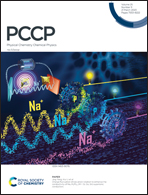Quantum mechanics/molecular mechanics studies on mechanistic photophysics of cytosine aza-analogues: 2,4-diamino-1,3,5-triazine and 2-amino-1,3,5-triazine in aqueous solution†
Abstract
The excited-state properties and photophysics of cytosine aza-analogues, i.e., 2,4-diamino-1,3,5-triazine (2,4-DT) and 2-amino-1,3,5-triazine (2-AT) in solution have been systematically explored using the QM(MS-CASPT2//CASSCF)/MM approach. The excited-state nonradiative relaxation mechanisms for the initially photoexcited S1(ππ*) state decay back to the S0 state are proposed in terms of the present computed minima, surface crossings (conical intersections and singlet–triplet crossings), and excited-state decay paths in the S1, S2, T1, T2, and S0 states. Upon photoexcitation to the bright S1(ππ*) state, 2,4-DT quickly relaxes to its S1 minimum and then overcomes a small energy barrier of 5.1 kcal mol−1 to approach a S1/S0 conical intersection, where the S1 system hops to the S0 state through S1 → S0 internal conversion (IC). In addition, at the S1 minimum, the system could partially undergo intersystem crossing (ISC) to the T1 state, followed by further ISC to the S0 state via the T1/S0 crossing point. In the T1 state, an energy barrier of 7.9 kcal mol−1 will trap 2,4-DT for a while. In parallel, for 2-AT, the system first relaxes to the S1 minimum and then S1 → S0 IC or S1 → T1 → S0 ISCs take place to the S0 state by surmounting a large barrier of 15.3 kcal mol−1 or 11.9 kcal mol−1, respectively, which heavily suppress electronic transition to the S0 state. Different from 2,4-DT, upon photoexcitation in the Franck–Condon region, 2-AT can quickly evolve in an essentially barrierless manner to nearby S2/S1 conical intersection, where the S2 and T1 states can be populated. Once it hops to the S2 state, the system will overcome a relatively small barrier (6.6 kcal mol−1vs. 15.3 kcal mol−1) through IC to the S0 state. Similarly, an energy barrier of 11.9 kcal mol−1 heavily suppresses the T1 state transformation to the S0 state. The present work manifests that the amination/deamination of the triazine rings can affect some degree of different vertical and adiabatic excitation energies and nonradiative decay pathways in solution. It not only rationalizes excited-state decay dynamics of 2,4-DT and 2-AT in aqueous solution but could also provide insights into the understanding of the photophysics of aza-nucleobases.

- This article is part of the themed collection: 2023 PCCP HOT Articles


 Please wait while we load your content...
Please wait while we load your content...